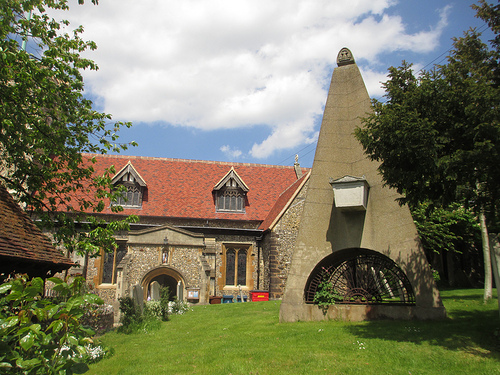Pinner’s Weird ‘Floating Coffin’
There are so many famous sights to see when you visit London that after a while you feel the need to see something different, something off the beaten track, something unusual that sets itself apart from the run of the mill visitor attractions, something that makes you think. Now Pinner is not generally on many tourist routes but if you are looking for some such diversion then Pinner is where you need to head, specifically the 14th century church of St John. The church may be ancient and atmospheric but it is the churchyard that you have come to see.

The Floating Coffin
Located at the top end of the town’s medieval high street is one of the most bizarre memorials you will ever see in any churchyard anywhere. It is only a small churchyard and in many ways mostly unremarkable, but amongst the lopsided grave stones you will find a large triangular, wedge shaped monument to the dead. The monument in itself is nothing out of the ordinary, but protruding from the unusual shaped memorial is a coffin. The ends of the casket poke out from either side of the stone monument, almost as though some unseen, giant hand had thrown it and with it speared the stone. This weird memorial was first brought to the public’s attention in 1902 by Charles Harper in his ‘Cycle Rides Around London’ book. He described it as being an odd tomb which was overgrown with ivy, the final resting place of a Mr William Loudon interred in 1809.
Local Legend
This stone encased casket has a back story that the simple epitaph on the coffin ends fails to relate to the visitor, in fact the engravings on the casket leave the visitor with far more questions than answers. However, William Loudon was a wealthy Scotch whiskey merchant, and in his will it is claimed that he bequeathed his property to his descendants who could retain the property providing that his mortal remains remained above the ground. The memorial was designed and erected by William’s son, John Claudius Loudon and dedicated to the memory of his parents William and Agnes. At the base of the stone monument are gated arches, the ancient iron work displaying the words ‘Byde-My-Tyme’, though what the souls interred here are waiting for is unknown.
Loudon’s Legacy
At the time of the erection of the memorial to his parents, Loudon, a well respected gardener and landscaper was employed on the creation of suburban cemeteries. He designed the layout and planting of cemeteries in Southampton, Cambridge and Bath, and his plans for the structure, design and management of public burial places were adopted by the City of London as the template for all of its cemeteries that were to follow, however, none of them can boast a memorial so dramatic or thought provoking as the floating coffin in his parent’s memorial. The incredible memorial was given Grade II Listed Building Status in 1983, ensuring that it will remain in place for many years to come.

